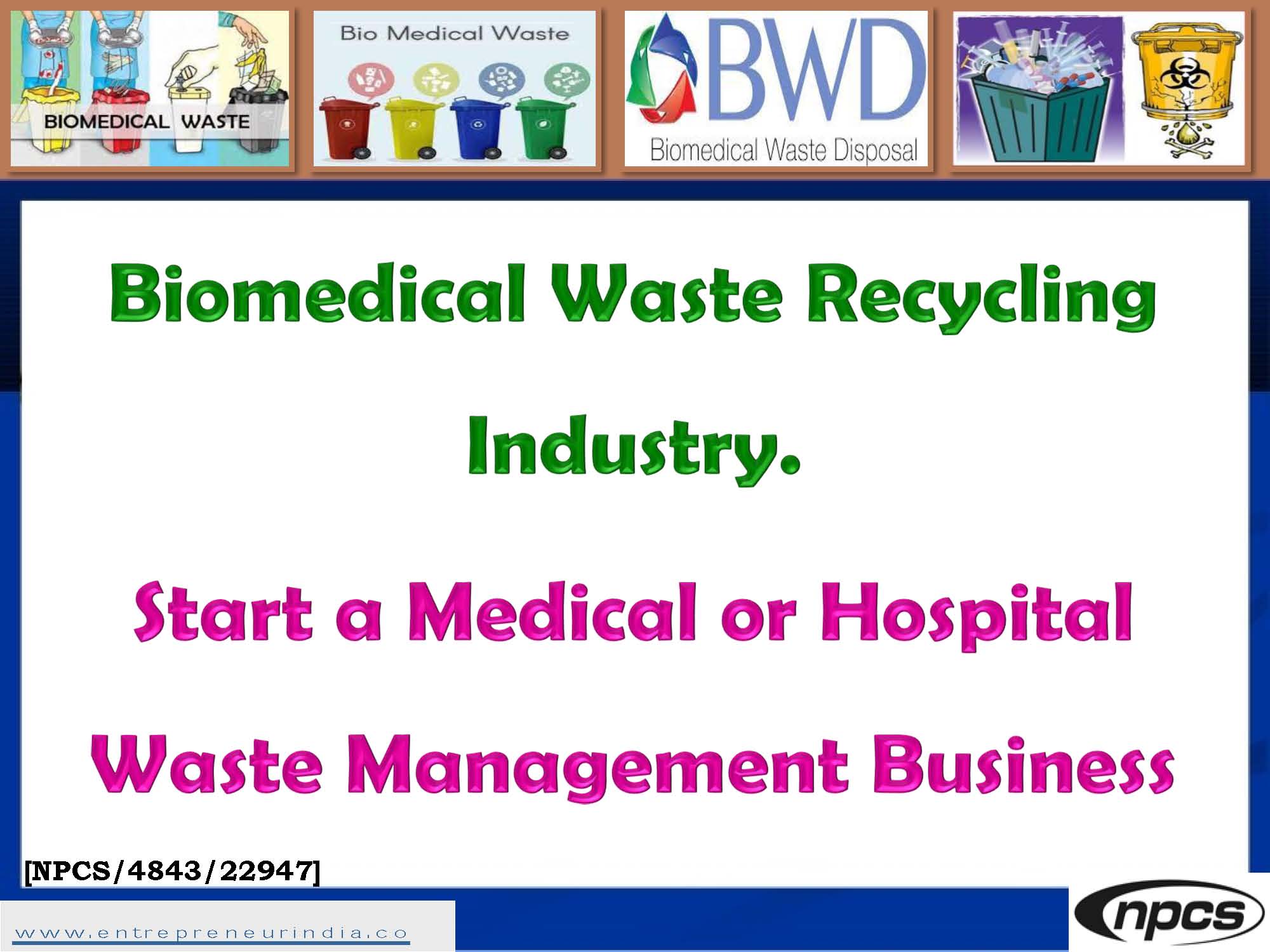
The Biomedical Waste Recycling Industry is rapidly emerging as one of the most vital sectors in modern waste management and healthcare logistics. With the exponential growth in hospitals, diagnostics centers, and medical research institutions, the generation of biomedical waste has also increased significantly. Managing this hazardous waste is not just an environmental necessity but also a public health obligation. As governments and healthcare authorities tighten regulations, the Biomedical Waste Recycling Industry is becoming a critical pillar of sustainable healthcare infrastructure and a highly promising business opportunity.
Scope and Importance of Biomedical Waste Recycling
Biomedical waste includes materials contaminated with blood, body fluids, infectious agents, and other hazardous substances. These range from used syringes, bandages, expired medicines, to surgical instruments and laboratory waste. If not treated or disposed of correctly, they can cause serious infections, environmental pollution, and even fatal disease outbreaks.
The Biomedical Waste Recycling Industry provides an eco-friendly, safe, and regulated way to treat, sterilize, segregate, and recycle medical waste into reusable or inert material. This sector not only prevents environmental damage but also reduces the carbon footprint of the healthcare industry. Furthermore, recycled components such as plastics and metals from medical tools can be reused in non-medical applications, adding commercial value.
Regulatory Landscape and Legal Mandates
The Biomedical Waste Recycling Industry is governed by stringent regulations laid down by national and international bodies. In India, the Biomedical Waste Management Rules, 2016, enforced by the Central Pollution Control Board (CPCB), are the key regulatory framework. These rules require all healthcare facilities to segregate and dispose of waste at authorized treatment plants.
Key compliance factors include:
-
Authorization from State Pollution Control Board (SPCB)
-
Adherence to color-coded segregation guidelines
-
Use of barcoded bags and containers
-
On-site storage limits and proper labeling
-
Timely collection by licensed waste handlers
-
Monthly reporting and waste tracking
This regulatory environment ensures that businesses in the Biomedical Waste Recycling Industry maintain high standards of safety and transparency.
Categories of Biomedical Waste and Recyclable Streams
Biomedical waste is generally divided into four major categories:
-
Yellow – Incineration waste like human tissue, body parts, soiled waste
-
Red – Recyclable contaminated waste like tubing, syringes (without needles), gloves
-
White (Translucent) – Sharps waste such as needles, scalpels, blades
-
Blue – Glassware and metallic body implants
The Biomedical Waste Recycling Industry mainly focuses on Red, White, and Blue categories, which include:
-
Plastic components (tubes, IV bottles, catheters) – sterilized and converted into plastic granules
-
Metal sharps and surgical tools – autoclaved and melted for use in other industrial applications
-
Glass vials and ampoules – crushed and sent to glass manufacturing units
Non-recyclable items are sent for incineration or deep burial as per standards.
Required Infrastructure and Machinery
To set up a unit in the Biomedical Waste Recycling Industry, you’ll need infrastructure and equipment tailored to safety and sterilization. A standard facility includes:
-
Segregation and sorting zone
-
Autoclaves or Hydroclaves – for steam sterilization
-
Microwave Treatment Units – alternative non-burn technology
-
Shredders and Granulators – for plastic and metal waste
-
Sharps destruction device – for needles and blades
-
Effluent Treatment Plant (ETP) – for water and chemical discharge
-
Storage areas – for both untreated and treated waste
-
Emission control systems – if using incinerators
Depending on capacity, the area requirement ranges from 5,000 to 20,000 sq. ft. with strict zoning and pollution control approval.
Investment and Cost Estimation
Capital investment for a medium-scale Biomedical Waste Recycling Industry project includes:
-
Land & Building: ?25–50 lakhs (owned or leased)
-
Machinery and Equipment: ?70 lakhs–?1.5 crores
-
Laboratory Setup & Testing Kits: ?5–10 lakhs
-
Compliance & Licensing: ?2–5 lakhs
-
Working Capital (first 6 months): ?20–30 lakhs
Total startup costs generally fall between ?1.5 crore and ?2.5 crore, depending on automation, capacity, and location.
Despite the high entry cost, profitability is strong due to consistent demand, long-term contracts with hospitals, and low competition.
Revenue Model and Profitability
The Biomedical Waste Recycling Industry works primarily on a service + product model:
-
Waste Treatment Fees – Charged per kilogram or per bed (?5–?15/kg) from hospitals, labs, and clinics
-
Sale of Recycled Materials – Plastic granules, metal scraps, and glass waste
-
Annual Maintenance Contracts (AMC) – For large hospitals needing exclusive collection
-
Consulting and Compliance Services – For smaller medical centers
With operational efficiency, businesses can expect 30–45% gross profit margins, and ROI within 2–3 years. Partnering with urban hospitals or creating mobile collection units can further enhance outreach.
Manpower and Skills Needed
A functional unit in the Biomedical Waste Recycling Industry will need:
-
Plant manager with environmental science or waste management background
-
Trained waste handling staff
-
Equipment operators (autoclave, shredder, ETP)
-
Health & safety officers
-
Marketing and liaison personnel
-
Data entry and compliance executives
All employees must be trained in hazardous waste handling and follow PPE (Personal Protective Equipment) protocols strictly.
Challenges and Mitigation
While promising, the Biomedical Waste Recycling Industry faces challenges:
-
Public health risks – due to improper handling
-
Strict audits and penalties – from pollution control boards
-
Community resistance – to waste treatment units in residential zones
-
Transportation logistics – for timely collection from multiple sites
To mitigate these, operators should invest in automation, employee training, GPS-enabled tracking, and frequent engagement with local authorities and community leaders.
Government Support and Schemes
Governments support the Biomedical Waste Recycling Industry through:
-
Pollution Control Board grants and approvals
-
Startup India recognition and incentives
-
MSME loans from SIDBI and nationalized banks
-
Technology Development Funds for eco-friendly machinery
-
Smart Cities Mission – requiring modern biomedical treatment units
These programs help reduce entry barriers and encourage more entrepreneurs to invest in this critical segment.
Conclusion
The Biomedical Waste Recycling Industry is no longer just a compliance measure—it’s an essential service that directly impacts public health and environmental safety. With increasing healthcare infrastructure, regulatory push, and sustainability awareness, the market is primed for exponential growth. If you’re considering entering a high-impact, recession-proof, and socially relevant industry, biomedical waste recycling offers strong potential, long-term revenue, and opportunities to make a real difference.
Niir Project Consultancy Services
An ISO 9001:2015 Company
106-E, Kamla Nagar, Opp. Spark Mall,
New Delhi-110007, India.
Email: npcs.ei@gmail.com , info@entrepreneurindia.co
Tel: +91-11-23843955, 23845654, 23845886, 8800733955
Mobile: +91-9811043595
Website: www.entrepreneurindia.co , www.niir.org





